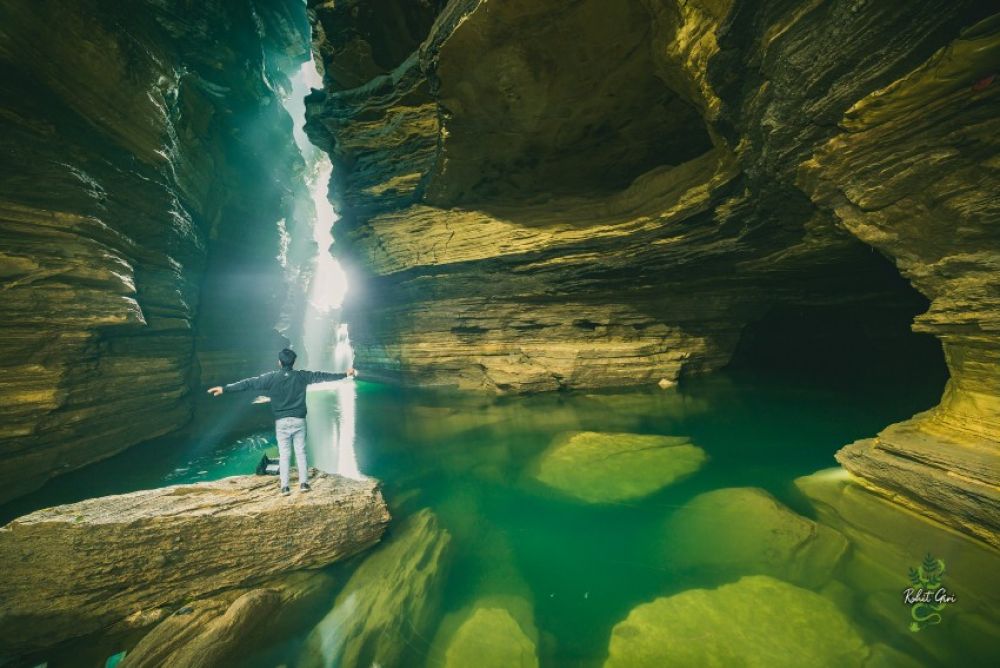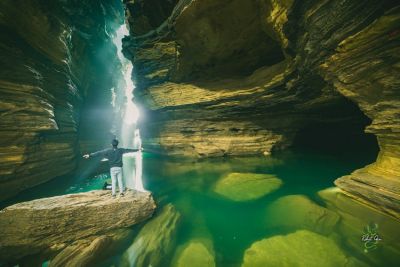

Gupteshwor Mahadev Cave in Pokhara is one of the most popular tourist attractions, dedicated to Lord Shiva. The cave is revered as a natural wonder that showcases the beauty of underground formations. As you enter, the stone staircase descends into a dark and damp corridor leading to the heart of the cave, where a naturally formed Shiva Lingam stands, drawing pilgrims and tourists alike. The exploration involves walking through narrow passages and appreciating the stalactites and stalagmites. The sound of the water from the underground Devi's Fall adds a sense of adventure to the tour. The cave’s natural acoustics with the echoing water sounds create an enigmatic atmosphere. The journey inside the cave can be a bit challenging due to wet floors and dim lighting, so it's advisable to wear good shoes and perhaps carry a flash-light.
The unique geological structures inside Gupteshwor Mahadev Cave provide a perfect backdrop for photography enthusiasts. The play of light through the narrow openings and the eerie shadows cast by the peculiar rock formations create an opportunity for capturing some incredible photographs. Visitors can enjoy snapping pictures of the cave's stalactites and the revered Shiva Lingam. Whether you are a professional photographer looking to add some stunning cave shots to your portfolio or an amateur wanting to document your adventure in Pokhara, this activity will not disappoint. Just ensure to have a camera suitable for low light conditions and be mindful of the cave’s moisture that could potentially harm electronic devices.
For those on a spiritual journey, a visit to the Gupteshwor Mahadev Cave offers a unique pilgrimage experience. The site is of great religious significance to Hindus as it houses the naturally formed Shiva Lingam. Devotees believe that paying homage here brings blessings and good fortune. During Shivaratri and other auspicious dates in the Hindu calendar, the cave sees an influx of worshippers participating in rituals and prayers. Visitors can observe local religious practices and may even partake in the offerings to the deity. The spiritual ambiance inside the cave, accompanied by the distant sound of the water from Devi's Fall, provides a serene setting for reflection and devotion.
Adventure seekers can find a thrilling caving experience in Gupteshwor Mahadev Cave. While part of the cave is well-trodden by pilgrims and tourists, there are sections that offer a more rugged and less developed environment for the adventurous. These areas may require some crawling and squeezing through tight spaces. Caving gear such as helmets and headlamps are highly recommended, and it would be wise to opt for a guided tour if you're unfamiliar with the terrain. The thrill of navigating through the less explored parts of the cave and potentially discovering unseen formations is a draw for many caving enthusiasts. Though it's essential to stay mindful of the cave’s fragile ecosystem and respect the sacred nature of some areas within the cave complex.
The quiet and mystic surroundings inside the Gupteshwor Mahadev Cave provide an ideal atmosphere for meditation and yoga practice. Experience serenity and inner peace as you meditate to the natural symphony of dripping water and distant river flows in the background. The almost palpable spirituality of the cave adds to the depth of a yoga session. Yoga enthusiasts can find secluded spots to roll out their mats and practice asanas in the natural cave environment. This is not a formal activity offered at the cave, but individuals seeking a unique spiritual experience often use the cave as a retreat for their personal practice. Respect for the religious significance of the cave and other visitors is paramount for those wishing to engage in this activity.
Educational institutions often organize study tours to Gupteshwor Mahadev Cave for students of geology, history, and culture. It provides an excellent field trip site where students can observe and learn about cave formations, rock types, and natural erosion processes. The cave also provides insights into Nepalese religious practices and pilgrimage tourism. Academic professionals and tour guides often provide lectures or guided tours explaining the geological significance, the history of the cave's discovery, and its place in the religious fabric of Nepal. Students often engage in interactive learning sessions, making sketches, taking notes, and asking questions to better understand the cave's natural and cultural aspects.
Around the entrance of Gupteshwor Mahadev Cave, a small market area caters to tourists and pilgrims looking to buy souvenirs, religious artifacts, and local crafts. While not an activity within the cave itself, it is an integral part of the visit for many. You can find items such as handicrafts made from local materials, traditional Nepali clothing items, and jewelry. Religious trinkets and tokens purported to be blessed in the sacred cave can also be found here. Bargaining is a common practice in these markets, so visitors can enjoy the hustle of haggling with shopkeepers for the best price on their chosen mementos. This shopping experience allows you to take home a piece of Pokhara's culture and spirituality.
Occasionally, visitors to Gupteshwor Mahadev Cave might encounter local musicians playing traditional Nepali music at the cave entrance or within certain chambers of the cave. The natural acoustics of the cave amplify the haunting sounds of instruments like the sarangi, tabla, and madal. This auditory experience is truly enchanting, adding to the mystique and allure of the cave visit. The musicians often play voluntarily, but tips are appreciated and provide direct support to the local artists. The blend of cultural music and natural cave ambiance creates a mesmerizing experience that can transport you to an ancient world where nature and culture coalesce beautifully.
Adjacent to Gupteshwor Mahadev Cave, there's a small, well-maintained garden area where visitors can relax and enjoy some quiet time. With a view of the cave’s surroundings and lush vegetation, it's a perfect spot to unwind after exploring the cave's depths. The garden is often less crowded than the cave, offering a peaceful respite. Families can often be seen picnicking here, and solo travelers find it a calming place to journal or read. The Garden does not offer extensive activities, but its simplicity and tranquility make it a much-appreciated feature of the Gupteshwor Mahadev Cave site.
A visit to Gupteshwor Mahadev Cave isn’t complete without tasting the local Nepali cuisine offered at the nearby eateries and food stalls. After exploring the cave, visitors can venture to these small establishments to enjoy traditional dishes like momo (dumplings), dal bhat (lentils with rice), and other local snacks. This provides not only a delicious end to the caving experience but also an opportunity to engage with local people and learn more about the culinary culture of Nepal. These food joints are typically family-owned and offer a homely atmosphere where you can enjoy freshly prepared meals at reasonable prices.
